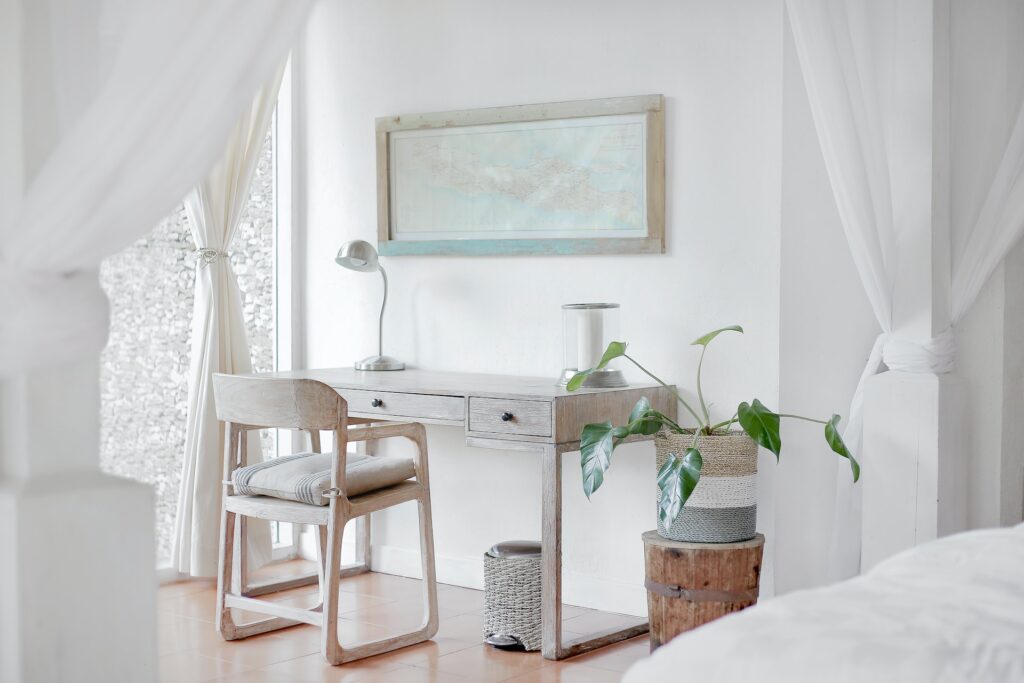Inside: Use these helpful tips for minimalists who live with non-minimalists to create more peace and harmony in your home.
A guest post from Cora Gold
While minimalism has countless benefits, the lifestyle doesn’t appeal to everyone. Overconsumption and materialism are common in today’s world, so it can be difficult to try to convince people to embark on a new way of life.
If you’re a minimalist living with someone who is not, chances are you’ve had a few squabbles over how much needs to be in your home. It can be challenging to live with people who have different standards and expectations.
However, there are ways you can compromise even if they don’t practice minimalism. Use these helpful tips for minimalists who live with non-minimalists to open up conversations and create compromises that will bring more harmony to your home.

11 Tips for Minimalists Who Live with Non-Minimalists
Use these tips for minimalists who live with non-minimalists to create a more peaceful environment.
1. Start With Your Items
One of the top ways to annoy a non-minimalist is to start organizing or eliminating their items — especially when you haven’t worked on your own stuff first.
Declutter your own things if you’re starting or working to maintain a minimalist lifestyle. Once your items are narrowed down, you can consult other members of the household about doing the same.
Always ask permission before rearranging or eliminating someone else’s items, regardless of how well you know them. It’s important that your partner feels respected even if they aren’t ready to declutter their things yet.
The same goes if you have kids living at home. Don’t start by getting rid of their things. Work on yours first and then help them learn how to declutter their stuff by working together.
2. Explain Why You Want Minimalism
Many people understand the concept of minimalism, but some don’t realize why it’s important to you and so many others worldwide.
Explain to anyone in your household why a minimalist lifestyle matters to you — it costs less, reduces anxiety, helps the planet, and creates more freedom to rest and move around your home.
Once they understand the motivation behind your habits, they might also want to become a minimalist. At the very least, they’ll know where you’re coming from.

3. Don’t Push the Idea
No one wants someone to nag them about a habit they have. Pushing minimalism on someone who is hesitant will only drive them away from adopting the idea.
You can mention being a minimalist occasionally or ask to organize an area where they keep things. Over time, they may embrace the idea, as well as your values and habits.
But they also might choose not to and that’s ok as well. You can gently encourage someone to live a simpler lifestyle, but ultimately it is their choice to decide how they want to live.
4. Allow for Mistakes
Humans are creatures of habit. When we try to change, it’s easy to slip into our old ways from time to time.
If your partner or roommate wants to support your quest for minimalism, know that they are likely to miss the mark occasionally.
Having patience and grace throughout the process will help to keep things positive and further the motivation to adopt minimalist habits.

5. Use Creative Storage
They say “out of sight, out of mind.” That might not be entirely true, but some innovative storage options can help you feel better about the stuff in your home.
A great way for minimalists and non-minimalists to compromise is to agree on using storage items like cabinets, trunks, or armoires so that beloved items can be stored, but they don’t have to be seen all of the time.
With a little luck, maybe you’ll even forget the clutter is there over time.
6. Install Display Shelves
Sometimes, excess items aren’t cluttered if shown in the right way. If your partner or roommate loves collecting knickknacks or trinkets, consider installing a display shelf or two.
With permission, you can arrange the items in a unique pattern that can bring visual interest without overwhelming your home. You can make these shelves yourself or purchase them in a home store or online.
If seeing these items on display will create too much visual clutter for you, work on finding a room to put it in where you don’t have to see it as often.

7. Make Minimalist Spaces
It can be hard not to feel stressed when living in a cluttered environment. You can mitigate this problem by compromising on minimalist areas.
Decide together which rooms or areas can have clutter and which you can keep more minimalist.
Set up the minimalist spaces in a way that you enjoy. Whether it’s a living room corner, home office, or bathroom countertop, these spaces can feel like a breath of fresh air so that you can more fully relax in your home.
8. Embrace Neutral Colors
Neutral colors can transform a home into a blank canvas or tone down a colorful area. They work well with minimalism as they can make a room feel cleaner and larger, reflecting natural light from windows while creating opportunities for stylish artwork and pops of color.
Speak with your household members about either painting or adding neutral colors throughout your home. If your spouse wants to add their own decorations, the neutral backdrop will help make the space less overwhelming.
You can work together to use minimalist design in your home without it feeling like a boring space.

9. Work Together on Ground Rules
One of the best ways to compromise with someone who is not into minimalism is to set ground rules together. These include the decluttering habits you want to develop in your home to create a space you’re both comfortable living in.
Decide together ahead of time what common areas you can work on together and which areas you will each leave alone for the other to manage.
Creating a set of concrete compromises means there will be fewer arguments since you both will know how to handle the situation before it becomes an issue.
10. Keep Your Floors Clear
Even if there’s nothing on a wall or shelf, a cluttered floor can create that claustrophobic feeling minimalism fights against. However, a full space can still feel open and breathable if your floors and windows are clear.
Create a ground rule about removing items from the floor that don’t belong there so it remains clear for walking, sitting, and other activities.
Decluttering certain areas, like the entryway, will help to save you more time as well as create a less cluttered space. Make sure to give everyone specific places to put their things to help keep the home picked up.

11. Accept What You Can’t Change
Frustration often stems from unmet expectations, so the more you can communicate and work together to come to a mutual understanding, the better off everyone will be. Also, remember that developing new household habits takes time.
In the end, no matter how you compromise or what you suggest, you can’t control anyone but yourself. When you accept the things you can’t change, your anxiety about the situation will decrease, helping you focus on other things that make a positive difference in your life.
Minimalism is a journey that can be challenging and uncomfortable for many people. Recognize that you can’t force someone to change. With small compromises, you can show them the benefits without invalidating their feelings.
Embracing Minimalism in a Non-Minimal Home
There’s only so much you can do to create a minimalist space when not everyone is on board — and that’s OK. Minimalism has many benefits, but just because it brings you joy doesn’t mean it will do the same for everyone.
Trying to live as a minimalist in a small space filled with another person’s things can be frustrating at times. Even if you may not always feel like it, remember that you’re on the same team.
Continue making choices that align with your beliefs and values. And keep in mind that compromise and understanding are important elements of a healthy relationship.

Cora Gold is the Editor-in-Chief of Revivalist magazine. She loves writing about family and living life to the fullest. Follow Cora on Twitter, Facebook and Pinterest.
What’s your favorite tip for minimalists who live with non-minimalists? Share it in the comments section.
Sign up on the form below to get weekly decluttering tips sent straight to your inbox. You’ll also get the free Your Home Decluttered Jumpstart which includes 100 easy items to declutter and 12 high-impact areas to declutter in 10 minutes.


Thankyou. This was helpful
‘We’ have a problem in our household, just me and my partner. i find tools and products that have been used on a previous day, still sat where they were last used. items such as diy tools in the geeenhouse. i have now bought a load of buckets £1.00 each, which are going to have a letter on, these will be suspended from the shed beams. g= green house, c= car, p= plumbing, e= electrics. When i find an item in the house, where it shouldnt be, it will go in one of these buckets, it also looks as if its going to produce order in the shed too.
You can’t change the spots on a leopard! To some, this is not priority. When you are told ” I have better things to do with my time”, I gave up trying! His choice to live in a mess, don’t ask me when you can’t find something. My answer to him”check where you left it” !
Thanks Julianna
About 3 months ago I had a very serious accident and was airlifted to a major hospital’s trauma unit where I stayed for some weeks.
I was provided with six weeks of domestic help following leaving the hospital. After the six weeks was over with me in a lovely clean home, I didn’t know what to do. How was I going to cope?
Now, thanks to your suggestions here, I do. Five minutes of declutering and even cleaning is better than nothing. I understand that now and am working towards it.
I have been suggesting to friends or clients with sudden or longterm health issues a lot of your earlier suggestions but it had gone into deaf ears.
But what you said in your second blog makes so much sense…….to me.
Again, thank you.
In shared spaces like the office, my approach is to keep my own computer area neat, and my drawers orderly (I’m not a perfectionist, but I leaned many years ago that I hate wasting time looking for things). I don’t touch his desk drawers or shelves. If shared spaces get cluttered, I ask him to schedule a time when we can go through it together and find locations that will work for both of us. Over time he has learned that he gets frustrated when he can’t lay his hands on a receipt or a medical record, and he will periodically do this on his own. Living spaces like kitchen, bedroom, multi-purpose room, etc. are not a problem. He has a workshop on the lower level, and we have a storage room adjacent. I don’t bother with the workshop. Periodically (once or twice a year), when I get frustrated, I will schedule a cleanup session in the storage room — at his convenience. Overall these compromises work for both of us. He is not a hoarder, and he enjoys the open spaces — he just does not want to spend HIS time decluttering!.
My husband has an antique dresser in the lounge room with his antique nicknacks and keepsakes on it. That’s his zone.